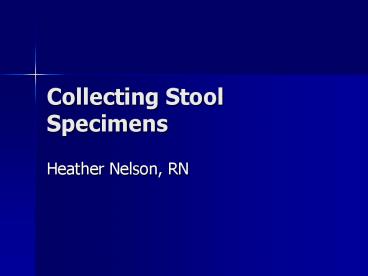Collecting Stool Specimens PowerPoint PPT Presentation
Title: Collecting Stool Specimens
1
Collecting Stool Specimens
- Heather Nelson, RN
2
Collecting Stool Specimens
- The nurse needs to determine the reason for
collecting the stool specimen and the correct
method of obtaining and handling it (i.e., how
much stool to obtain, whether a preservative
needs to be added to the stool, and whether it
needs to be sent immediately to the laboratory). - Confirm handing of stool with the hospital
laboratory if necessary.
3
Nurses Need to Instruct Patients
- To defecate in a clean or sterile bedpan or
bedside commode. - Do not contaminate the specimen with urine or
menstrual discharge if possible. Void before the
specimen collection. - Do not place toilet tissue in the bedpan or hat
after defecation, since contents of the paper can
affect the laboratory analysis. - Notify the nurse as soon as possible after
defecation, particularly for specimens that need
to be sent to the laboratory immediately.
4
Obtaining sample from a baby
- Obtain newly passed feces from the diaper.
5
Obtaining Stool Samples
- The nurse should follow medical aseptic
technique. - Wear gloves to prevent hand contamination.
- Take care not to contaminate the outside of the
specimen container. - Use clean tongue blades to transfer the specimen
to the container.
6
Obtaining Stool Samples
- The amount of stool to be sent to the lab depends
on the purpose for which the specimen is
collected. - Usually about 2.5 cm (1 inch) of formed stool or
15 to 30 ml of liquid stool is adequate. - For some timed specimens, the entire stool passed
may need to be sent. - Confirm with the lab the size of the sample
required.
7
Obtaining Stool Samples
- Visible pus, mucus, or blood should be included
in sample specimens. - For a stool culture, dip a sterile swab into the
specimen and place the swab in a sterile test
tube.
8
Obtaining Stool Samples
- Send the specimen to the lab immediately.
- If this is not possible, follow the directions on
the specimen container.
PowerShow.com is a leading presentation sharing website. It has millions of presentations already uploaded and available with 1,000s more being uploaded by its users every day. Whatever your area of interest, here you’ll be able to find and view presentations you’ll love and possibly download. And, best of all, it is completely free and easy to use.
You might even have a presentation you’d like to share with others. If so, just upload it to PowerShow.com. We’ll convert it to an HTML5 slideshow that includes all the media types you’ve already added: audio, video, music, pictures, animations and transition effects. Then you can share it with your target audience as well as PowerShow.com’s millions of monthly visitors. And, again, it’s all free.
About the Developers
PowerShow.com is brought to you by CrystalGraphics, the award-winning developer and market-leading publisher of rich-media enhancement products for presentations. Our product offerings include millions of PowerPoint templates, diagrams, animated 3D characters and more.

